Ritz-Carlton Business Management Case Study
VerifiedAdded on 2023/06/10
|10
|2287
|126
AI Summary
This case study covers leadership styles, theories, organizational performance, and ethics in the context of Ritz-Carlton. It examines the connectivity between leadership frameworks and a company’s accomplishments through studying the limiting role of organizational procedures and policies.
Contribute Materials
Your contribution can guide someone’s learning journey. Share your
documents today.
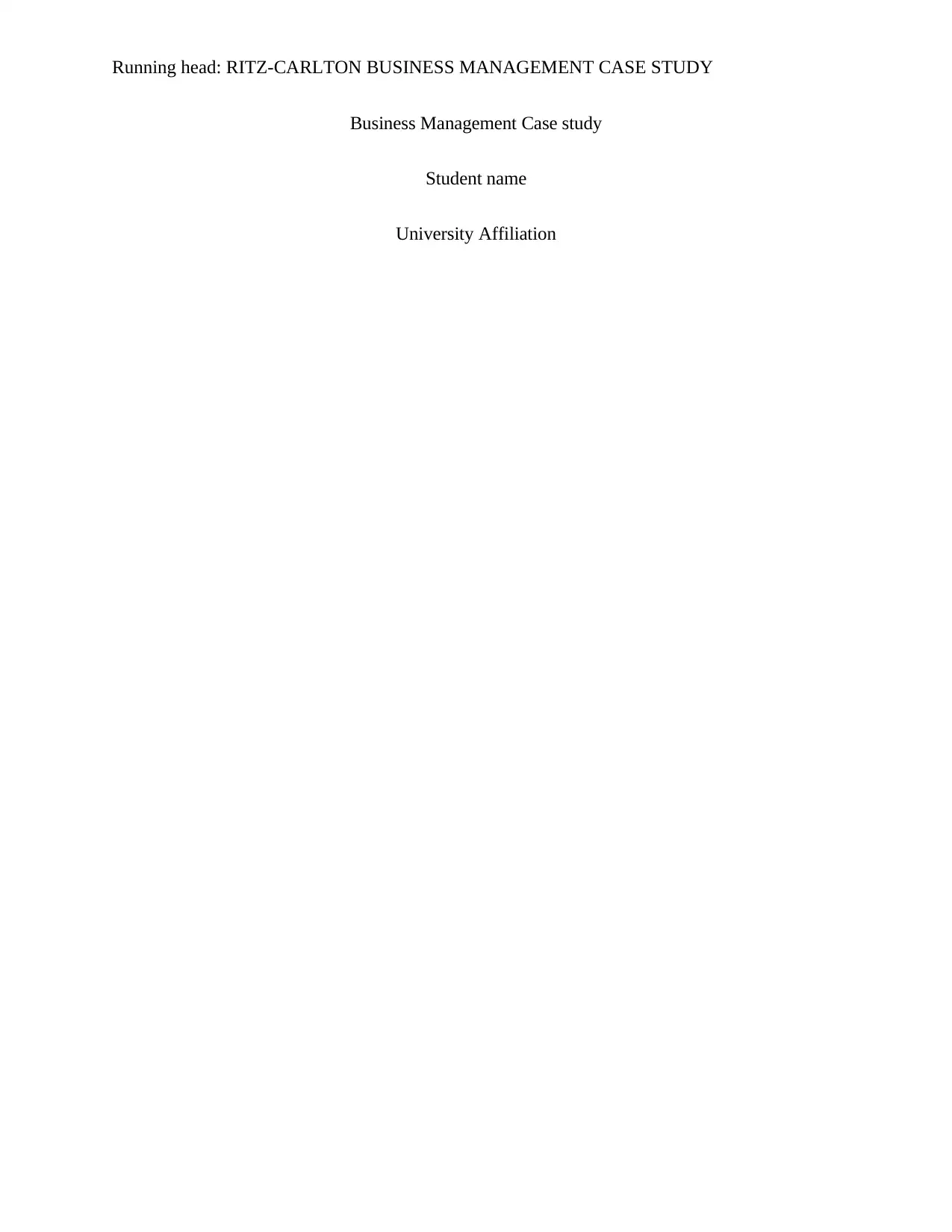
Running head: RITZ-CARLTON BUSINESS MANAGEMENT CASE STUDY
Business Management Case study
Student name
University Affiliation
Business Management Case study
Student name
University Affiliation
Secure Best Marks with AI Grader
Need help grading? Try our AI Grader for instant feedback on your assignments.

Business Management
Executive summary
Big and competitive markets take over demands both group and transformational
management techniques to successfully achieve an organization’s targets. Revolutionary and
collective leadership approaches enable a manager to enter, determine and develop an existing or
new business venture. This leadership framework is a tactical switch from the old management
designs where the executives motivated their workforce promising them rewards on the
achievement of some set goals. Scholars usually refer to this leadership as being transactional
based. All successful entrance into an international market like the Portman Ritz-Carlton
Shanghai requires a manager who is highly skilled in emotional aspects ranging from empathy,
self-awareness, motivation, social skill, and self-regulation, (Goleman, 2013). Executives who
are enthusiasts of transformation usually perform in-depth analysis regarding the cultural
contexts, organizational personality advantages, and the company’s procedures and beliefs
(Serrat, 2017).
Leadership refers to the capacity to effectively steer the workforce within an organization
using given values while maintaining ethical standards. The current situation in the Portman Ritz-
Carlton Shanghai global, where there is continuous high notch contention amongst high ranked
international service industries, calls for an effective and performing leader. The high complexity
of the financial, social, technological, and civil influencers escalates the situations at such hotel
industries for the manager put in the position to direct and make critical decisions. The margin for
Executive summary
Big and competitive markets take over demands both group and transformational
management techniques to successfully achieve an organization’s targets. Revolutionary and
collective leadership approaches enable a manager to enter, determine and develop an existing or
new business venture. This leadership framework is a tactical switch from the old management
designs where the executives motivated their workforce promising them rewards on the
achievement of some set goals. Scholars usually refer to this leadership as being transactional
based. All successful entrance into an international market like the Portman Ritz-Carlton
Shanghai requires a manager who is highly skilled in emotional aspects ranging from empathy,
self-awareness, motivation, social skill, and self-regulation, (Goleman, 2013). Executives who
are enthusiasts of transformation usually perform in-depth analysis regarding the cultural
contexts, organizational personality advantages, and the company’s procedures and beliefs
(Serrat, 2017).
Leadership refers to the capacity to effectively steer the workforce within an organization
using given values while maintaining ethical standards. The current situation in the Portman Ritz-
Carlton Shanghai global, where there is continuous high notch contention amongst high ranked
international service industries, calls for an effective and performing leader. The high complexity
of the financial, social, technological, and civil influencers escalates the situations at such hotel
industries for the manager put in the position to direct and make critical decisions. The margin for
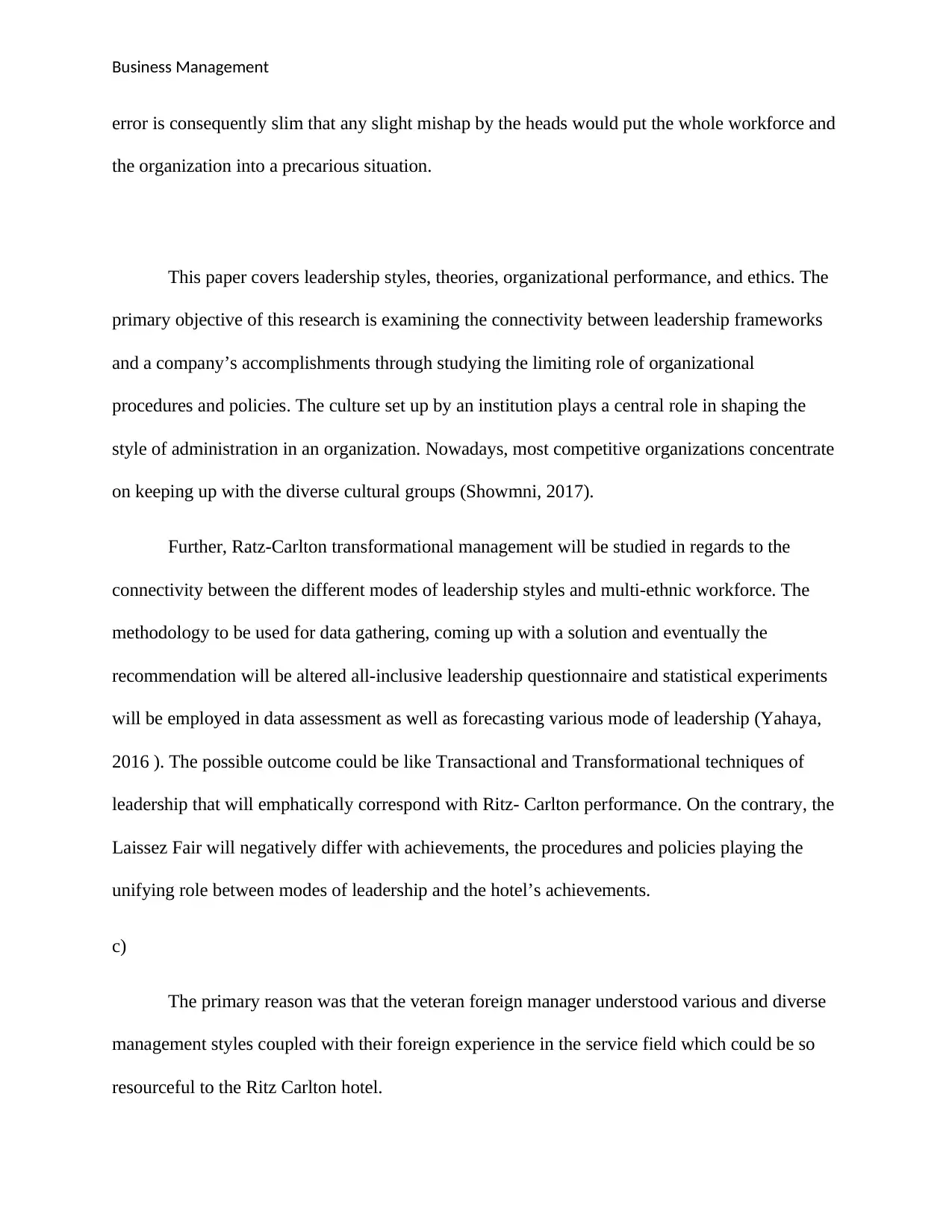
Business Management
error is consequently slim that any slight mishap by the heads would put the whole workforce and
the organization into a precarious situation.
This paper covers leadership styles, theories, organizational performance, and ethics. The
primary objective of this research is examining the connectivity between leadership frameworks
and a company’s accomplishments through studying the limiting role of organizational
procedures and policies. The culture set up by an institution plays a central role in shaping the
style of administration in an organization. Nowadays, most competitive organizations concentrate
on keeping up with the diverse cultural groups (Showmni, 2017).
Further, Ratz-Carlton transformational management will be studied in regards to the
connectivity between the different modes of leadership styles and multi-ethnic workforce. The
methodology to be used for data gathering, coming up with a solution and eventually the
recommendation will be altered all-inclusive leadership questionnaire and statistical experiments
will be employed in data assessment as well as forecasting various mode of leadership (Yahaya,
2016 ). The possible outcome could be like Transactional and Transformational techniques of
leadership that will emphatically correspond with Ritz- Carlton performance. On the contrary, the
Laissez Fair will negatively differ with achievements, the procedures and policies playing the
unifying role between modes of leadership and the hotel’s achievements.
c)
The primary reason was that the veteran foreign manager understood various and diverse
management styles coupled with their foreign experience in the service field which could be so
resourceful to the Ritz Carlton hotel.
error is consequently slim that any slight mishap by the heads would put the whole workforce and
the organization into a precarious situation.
This paper covers leadership styles, theories, organizational performance, and ethics. The
primary objective of this research is examining the connectivity between leadership frameworks
and a company’s accomplishments through studying the limiting role of organizational
procedures and policies. The culture set up by an institution plays a central role in shaping the
style of administration in an organization. Nowadays, most competitive organizations concentrate
on keeping up with the diverse cultural groups (Showmni, 2017).
Further, Ratz-Carlton transformational management will be studied in regards to the
connectivity between the different modes of leadership styles and multi-ethnic workforce. The
methodology to be used for data gathering, coming up with a solution and eventually the
recommendation will be altered all-inclusive leadership questionnaire and statistical experiments
will be employed in data assessment as well as forecasting various mode of leadership (Yahaya,
2016 ). The possible outcome could be like Transactional and Transformational techniques of
leadership that will emphatically correspond with Ritz- Carlton performance. On the contrary, the
Laissez Fair will negatively differ with achievements, the procedures and policies playing the
unifying role between modes of leadership and the hotel’s achievements.
c)
The primary reason was that the veteran foreign manager understood various and diverse
management styles coupled with their foreign experience in the service field which could be so
resourceful to the Ritz Carlton hotel.
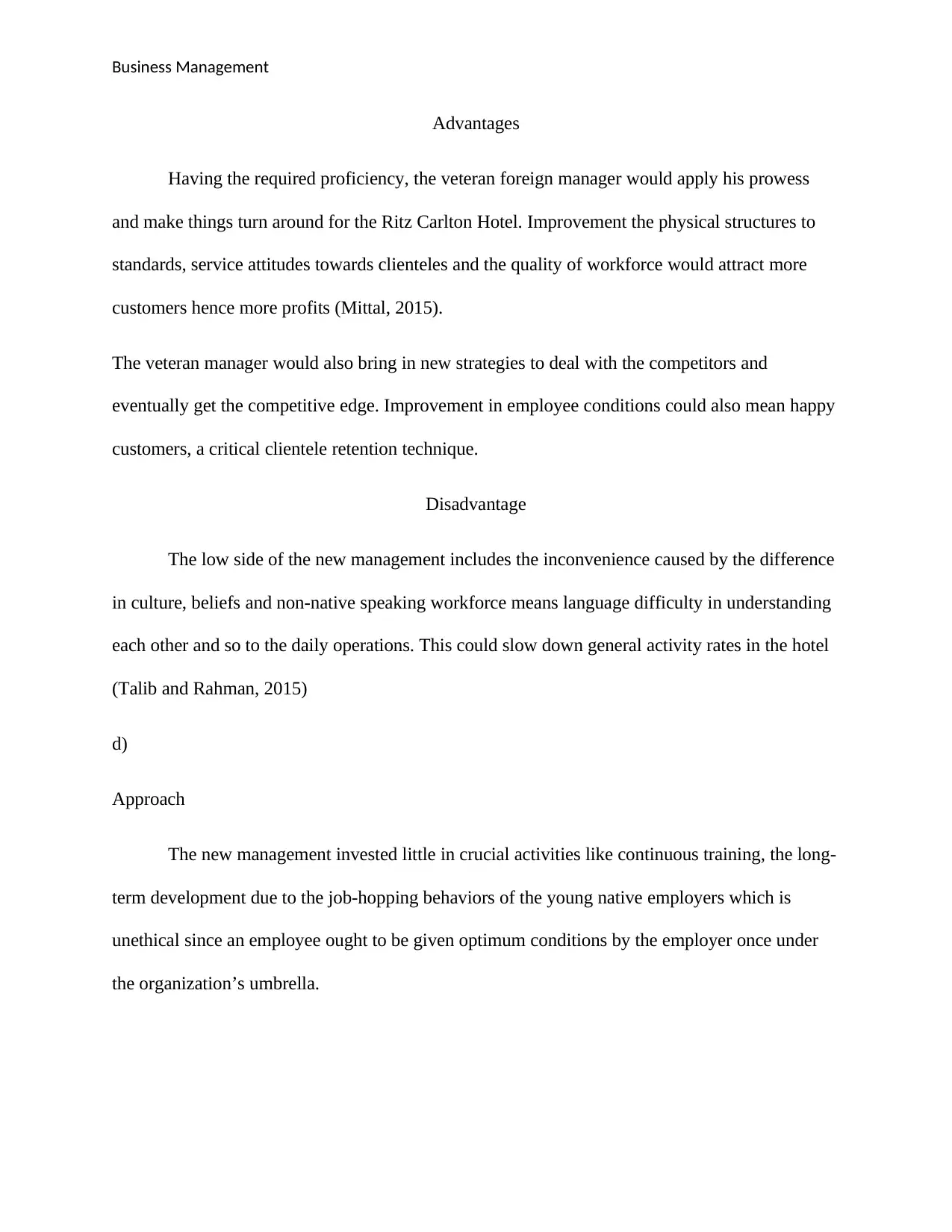
Business Management
Advantages
Having the required proficiency, the veteran foreign manager would apply his prowess
and make things turn around for the Ritz Carlton Hotel. Improvement the physical structures to
standards, service attitudes towards clienteles and the quality of workforce would attract more
customers hence more profits (Mittal, 2015).
The veteran manager would also bring in new strategies to deal with the competitors and
eventually get the competitive edge. Improvement in employee conditions could also mean happy
customers, a critical clientele retention technique.
Disadvantage
The low side of the new management includes the inconvenience caused by the difference
in culture, beliefs and non-native speaking workforce means language difficulty in understanding
each other and so to the daily operations. This could slow down general activity rates in the hotel
(Talib and Rahman, 2015)
d)
Approach
The new management invested little in crucial activities like continuous training, the long-
term development due to the job-hopping behaviors of the young native employers which is
unethical since an employee ought to be given optimum conditions by the employer once under
the organization’s umbrella.
Advantages
Having the required proficiency, the veteran foreign manager would apply his prowess
and make things turn around for the Ritz Carlton Hotel. Improvement the physical structures to
standards, service attitudes towards clienteles and the quality of workforce would attract more
customers hence more profits (Mittal, 2015).
The veteran manager would also bring in new strategies to deal with the competitors and
eventually get the competitive edge. Improvement in employee conditions could also mean happy
customers, a critical clientele retention technique.
Disadvantage
The low side of the new management includes the inconvenience caused by the difference
in culture, beliefs and non-native speaking workforce means language difficulty in understanding
each other and so to the daily operations. This could slow down general activity rates in the hotel
(Talib and Rahman, 2015)
d)
Approach
The new management invested little in crucial activities like continuous training, the long-
term development due to the job-hopping behaviors of the young native employers which is
unethical since an employee ought to be given optimum conditions by the employer once under
the organization’s umbrella.
Secure Best Marks with AI Grader
Need help grading? Try our AI Grader for instant feedback on your assignments.
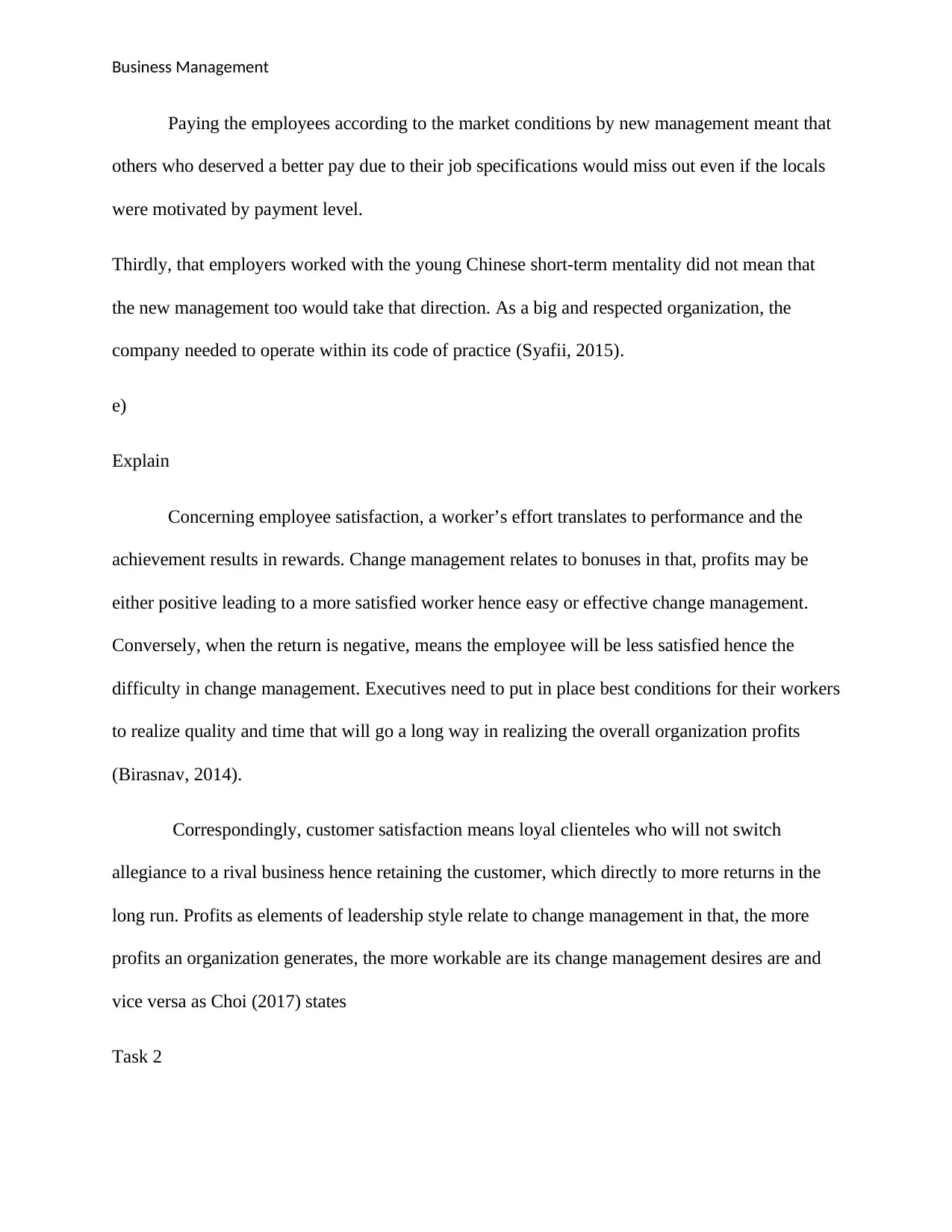
Business Management
Paying the employees according to the market conditions by new management meant that
others who deserved a better pay due to their job specifications would miss out even if the locals
were motivated by payment level.
Thirdly, that employers worked with the young Chinese short-term mentality did not mean that
the new management too would take that direction. As a big and respected organization, the
company needed to operate within its code of practice (Syafii, 2015).
e)
Explain
Concerning employee satisfaction, a worker’s effort translates to performance and the
achievement results in rewards. Change management relates to bonuses in that, profits may be
either positive leading to a more satisfied worker hence easy or effective change management.
Conversely, when the return is negative, means the employee will be less satisfied hence the
difficulty in change management. Executives need to put in place best conditions for their workers
to realize quality and time that will go a long way in realizing the overall organization profits
(Birasnav, 2014).
Correspondingly, customer satisfaction means loyal clienteles who will not switch
allegiance to a rival business hence retaining the customer, which directly to more returns in the
long run. Profits as elements of leadership style relate to change management in that, the more
profits an organization generates, the more workable are its change management desires are and
vice versa as Choi (2017) states
Task 2
Paying the employees according to the market conditions by new management meant that
others who deserved a better pay due to their job specifications would miss out even if the locals
were motivated by payment level.
Thirdly, that employers worked with the young Chinese short-term mentality did not mean that
the new management too would take that direction. As a big and respected organization, the
company needed to operate within its code of practice (Syafii, 2015).
e)
Explain
Concerning employee satisfaction, a worker’s effort translates to performance and the
achievement results in rewards. Change management relates to bonuses in that, profits may be
either positive leading to a more satisfied worker hence easy or effective change management.
Conversely, when the return is negative, means the employee will be less satisfied hence the
difficulty in change management. Executives need to put in place best conditions for their workers
to realize quality and time that will go a long way in realizing the overall organization profits
(Birasnav, 2014).
Correspondingly, customer satisfaction means loyal clienteles who will not switch
allegiance to a rival business hence retaining the customer, which directly to more returns in the
long run. Profits as elements of leadership style relate to change management in that, the more
profits an organization generates, the more workable are its change management desires are and
vice versa as Choi (2017) states
Task 2
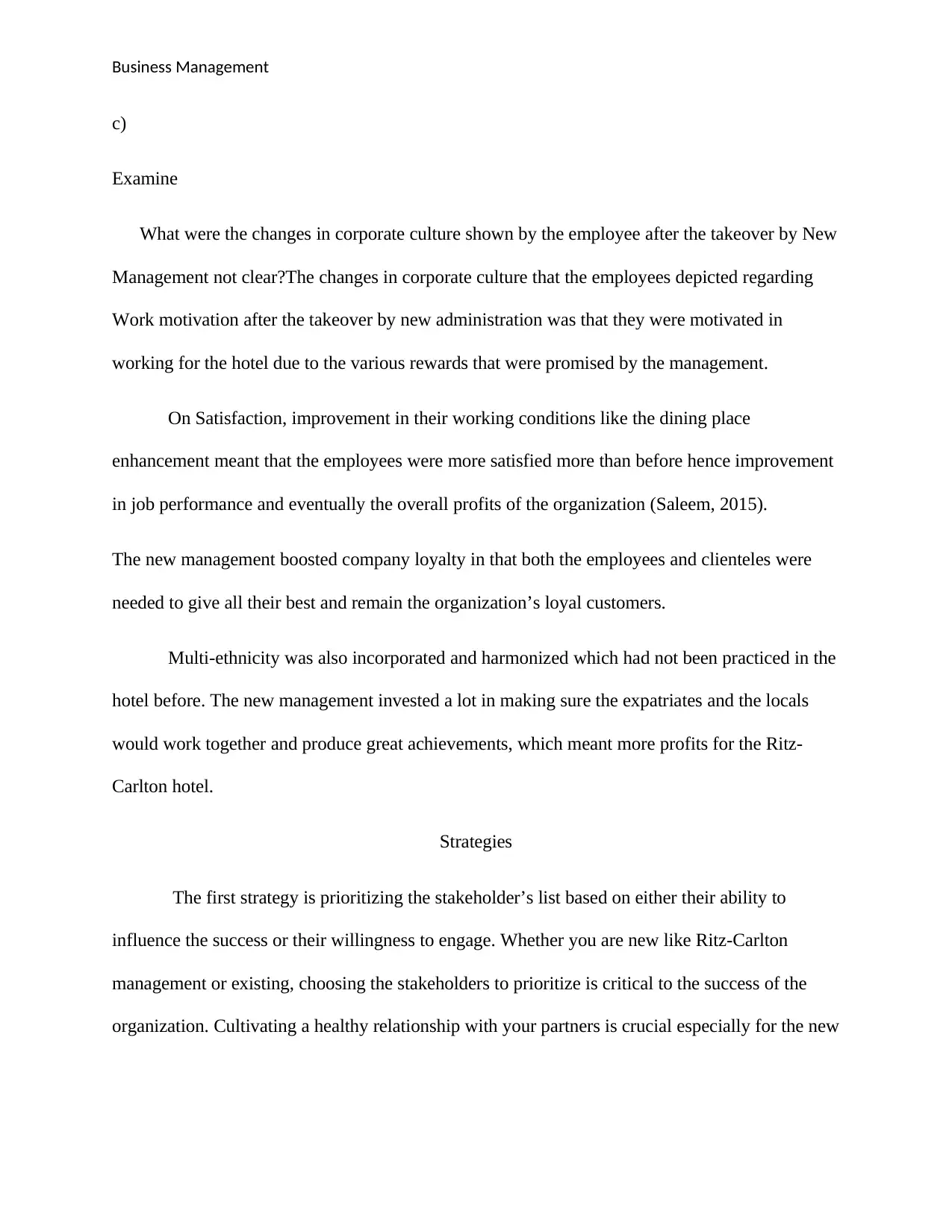
Business Management
c)
Examine
What were the changes in corporate culture shown by the employee after the takeover by New
Management not clear?The changes in corporate culture that the employees depicted regarding
Work motivation after the takeover by new administration was that they were motivated in
working for the hotel due to the various rewards that were promised by the management.
On Satisfaction, improvement in their working conditions like the dining place
enhancement meant that the employees were more satisfied more than before hence improvement
in job performance and eventually the overall profits of the organization (Saleem, 2015).
The new management boosted company loyalty in that both the employees and clienteles were
needed to give all their best and remain the organization’s loyal customers.
Multi-ethnicity was also incorporated and harmonized which had not been practiced in the
hotel before. The new management invested a lot in making sure the expatriates and the locals
would work together and produce great achievements, which meant more profits for the Ritz-
Carlton hotel.
Strategies
The first strategy is prioritizing the stakeholder’s list based on either their ability to
influence the success or their willingness to engage. Whether you are new like Ritz-Carlton
management or existing, choosing the stakeholders to prioritize is critical to the success of the
organization. Cultivating a healthy relationship with your partners is crucial especially for the new
c)
Examine
What were the changes in corporate culture shown by the employee after the takeover by New
Management not clear?The changes in corporate culture that the employees depicted regarding
Work motivation after the takeover by new administration was that they were motivated in
working for the hotel due to the various rewards that were promised by the management.
On Satisfaction, improvement in their working conditions like the dining place
enhancement meant that the employees were more satisfied more than before hence improvement
in job performance and eventually the overall profits of the organization (Saleem, 2015).
The new management boosted company loyalty in that both the employees and clienteles were
needed to give all their best and remain the organization’s loyal customers.
Multi-ethnicity was also incorporated and harmonized which had not been practiced in the
hotel before. The new management invested a lot in making sure the expatriates and the locals
would work together and produce great achievements, which meant more profits for the Ritz-
Carlton hotel.
Strategies
The first strategy is prioritizing the stakeholder’s list based on either their ability to
influence the success or their willingness to engage. Whether you are new like Ritz-Carlton
management or existing, choosing the stakeholders to prioritize is critical to the success of the
organization. Cultivating a healthy relationship with your partners is crucial especially for the new
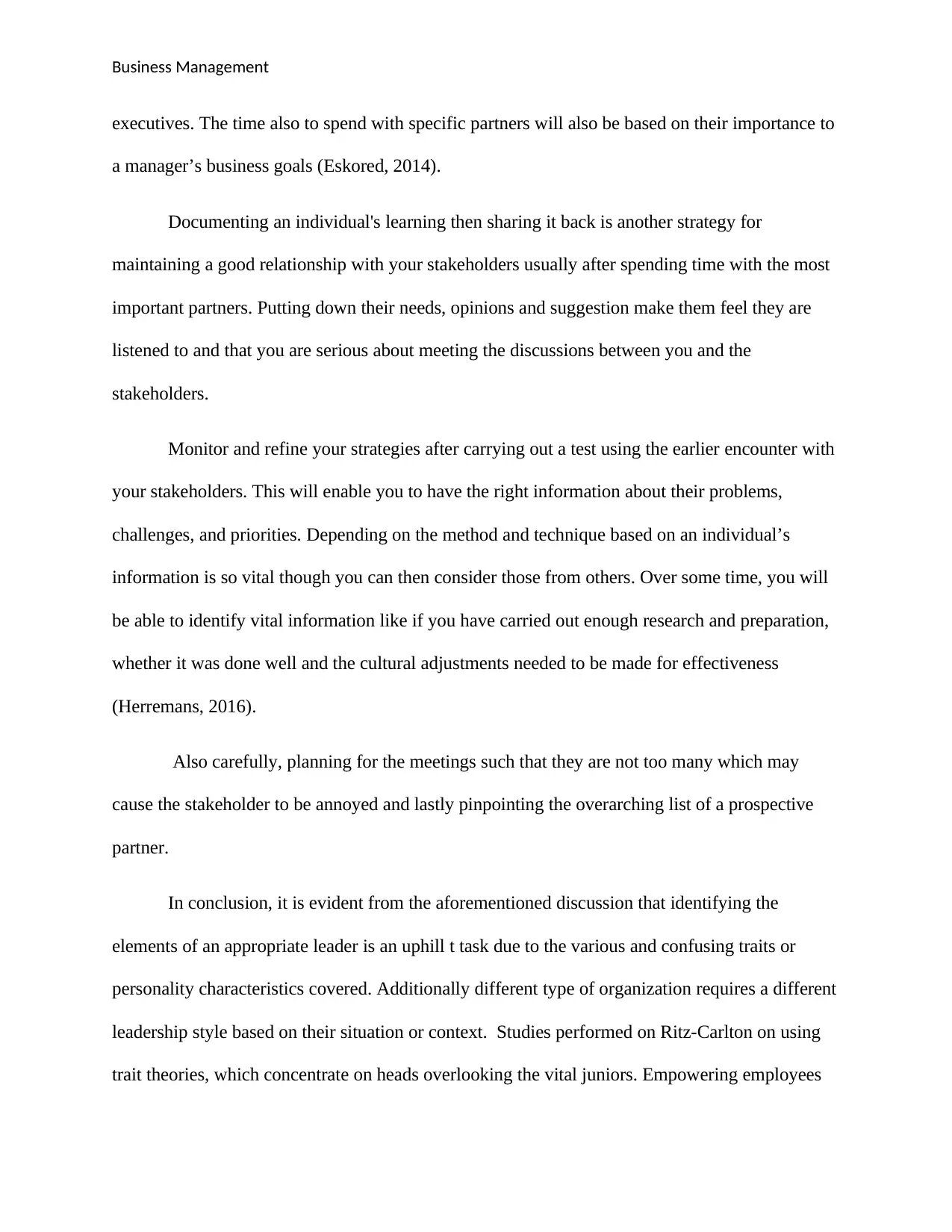
Business Management
executives. The time also to spend with specific partners will also be based on their importance to
a manager’s business goals (Eskored, 2014).
Documenting an individual's learning then sharing it back is another strategy for
maintaining a good relationship with your stakeholders usually after spending time with the most
important partners. Putting down their needs, opinions and suggestion make them feel they are
listened to and that you are serious about meeting the discussions between you and the
stakeholders.
Monitor and refine your strategies after carrying out a test using the earlier encounter with
your stakeholders. This will enable you to have the right information about their problems,
challenges, and priorities. Depending on the method and technique based on an individual’s
information is so vital though you can then consider those from others. Over some time, you will
be able to identify vital information like if you have carried out enough research and preparation,
whether it was done well and the cultural adjustments needed to be made for effectiveness
(Herremans, 2016).
Also carefully, planning for the meetings such that they are not too many which may
cause the stakeholder to be annoyed and lastly pinpointing the overarching list of a prospective
partner.
In conclusion, it is evident from the aforementioned discussion that identifying the
elements of an appropriate leader is an uphill t task due to the various and confusing traits or
personality characteristics covered. Additionally different type of organization requires a different
leadership style based on their situation or context. Studies performed on Ritz-Carlton on using
trait theories, which concentrate on heads overlooking the vital juniors. Empowering employees
executives. The time also to spend with specific partners will also be based on their importance to
a manager’s business goals (Eskored, 2014).
Documenting an individual's learning then sharing it back is another strategy for
maintaining a good relationship with your stakeholders usually after spending time with the most
important partners. Putting down their needs, opinions and suggestion make them feel they are
listened to and that you are serious about meeting the discussions between you and the
stakeholders.
Monitor and refine your strategies after carrying out a test using the earlier encounter with
your stakeholders. This will enable you to have the right information about their problems,
challenges, and priorities. Depending on the method and technique based on an individual’s
information is so vital though you can then consider those from others. Over some time, you will
be able to identify vital information like if you have carried out enough research and preparation,
whether it was done well and the cultural adjustments needed to be made for effectiveness
(Herremans, 2016).
Also carefully, planning for the meetings such that they are not too many which may
cause the stakeholder to be annoyed and lastly pinpointing the overarching list of a prospective
partner.
In conclusion, it is evident from the aforementioned discussion that identifying the
elements of an appropriate leader is an uphill t task due to the various and confusing traits or
personality characteristics covered. Additionally different type of organization requires a different
leadership style based on their situation or context. Studies performed on Ritz-Carlton on using
trait theories, which concentrate on heads overlooking the vital juniors. Empowering employees
Paraphrase This Document
Need a fresh take? Get an instant paraphrase of this document with our AI Paraphraser

Business Management
nowadays is the trend of most organizations through improved working conditions, attractive
bonuses, and favorable organizational policies, which go a long way in retaining the employees.
Revolutionary and charming theories of leadership identify various positive desirable qualities in
leaders. However, these qualities cannot be found in all managers. Leadership styles ought to be
workable and produce the required outcomes as planned to be considered effective.
References
Birasnav, M. (2014). Knowledge management and organizational performance in the service
industry: The role of transformational leadership beyond the effects of transactional
leadership. Journal of Business Research, 67(8), 1622-1629.
Choi, S. B., Kim, K., & Kang, S. W. (2017). Effects of transformational and shared leadership
styles on employees' perception of team effectiveness. Social Behavior and Personality: an
international journal, 45(3), 377-386.
Eskerod, P., & Vaagaasar, A. L. (2014). Stakeholder management strategies and practices during
a project course. Project Management Journal, 45(5), 71-85.
Goleman, D., Boyatzis, R. E., & McKee, A. (2013). Primal leadership: Unleashing the power of
emotional intelligence. Harvard Business Press.
Herremans, I. M., Nazari, J. A., & Mahmoudian, F. (2016). Stakeholder relationships,
engagement, and sustainability reporting. Journal of Business Ethics, 138(3), 417-435.
Lukose, S. (2015). A study on leadership styles, job related factors and organizational cultures
towards job satisfaction of teachers in the Diocese of Diphu, India.
nowadays is the trend of most organizations through improved working conditions, attractive
bonuses, and favorable organizational policies, which go a long way in retaining the employees.
Revolutionary and charming theories of leadership identify various positive desirable qualities in
leaders. However, these qualities cannot be found in all managers. Leadership styles ought to be
workable and produce the required outcomes as planned to be considered effective.
References
Birasnav, M. (2014). Knowledge management and organizational performance in the service
industry: The role of transformational leadership beyond the effects of transactional
leadership. Journal of Business Research, 67(8), 1622-1629.
Choi, S. B., Kim, K., & Kang, S. W. (2017). Effects of transformational and shared leadership
styles on employees' perception of team effectiveness. Social Behavior and Personality: an
international journal, 45(3), 377-386.
Eskerod, P., & Vaagaasar, A. L. (2014). Stakeholder management strategies and practices during
a project course. Project Management Journal, 45(5), 71-85.
Goleman, D., Boyatzis, R. E., & McKee, A. (2013). Primal leadership: Unleashing the power of
emotional intelligence. Harvard Business Press.
Herremans, I. M., Nazari, J. A., & Mahmoudian, F. (2016). Stakeholder relationships,
engagement, and sustainability reporting. Journal of Business Ethics, 138(3), 417-435.
Lukose, S. (2015). A study on leadership styles, job related factors and organizational cultures
towards job satisfaction of teachers in the Diocese of Diphu, India.
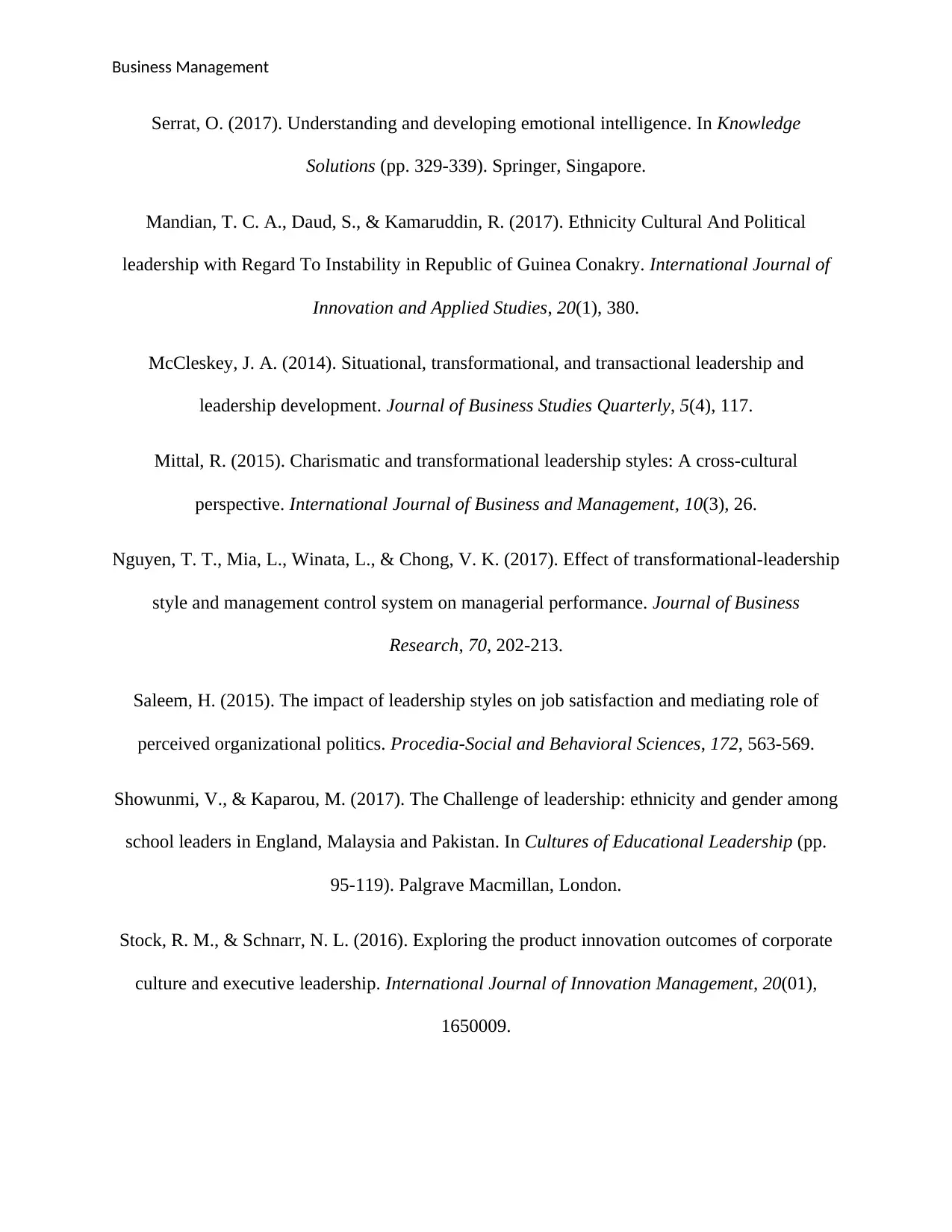
Business Management
Serrat, O. (2017). Understanding and developing emotional intelligence. In Knowledge
Solutions (pp. 329-339). Springer, Singapore.
Mandian, T. C. A., Daud, S., & Kamaruddin, R. (2017). Ethnicity Cultural And Political
leadership with Regard To Instability in Republic of Guinea Conakry. International Journal of
Innovation and Applied Studies, 20(1), 380.
McCleskey, J. A. (2014). Situational, transformational, and transactional leadership and
leadership development. Journal of Business Studies Quarterly, 5(4), 117.
Mittal, R. (2015). Charismatic and transformational leadership styles: A cross-cultural
perspective. International Journal of Business and Management, 10(3), 26.
Nguyen, T. T., Mia, L., Winata, L., & Chong, V. K. (2017). Effect of transformational-leadership
style and management control system on managerial performance. Journal of Business
Research, 70, 202-213.
Saleem, H. (2015). The impact of leadership styles on job satisfaction and mediating role of
perceived organizational politics. Procedia-Social and Behavioral Sciences, 172, 563-569.
Showunmi, V., & Kaparou, M. (2017). The Challenge of leadership: ethnicity and gender among
school leaders in England, Malaysia and Pakistan. In Cultures of Educational Leadership (pp.
95-119). Palgrave Macmillan, London.
Stock, R. M., & Schnarr, N. L. (2016). Exploring the product innovation outcomes of corporate
culture and executive leadership. International Journal of Innovation Management, 20(01),
1650009.
Serrat, O. (2017). Understanding and developing emotional intelligence. In Knowledge
Solutions (pp. 329-339). Springer, Singapore.
Mandian, T. C. A., Daud, S., & Kamaruddin, R. (2017). Ethnicity Cultural And Political
leadership with Regard To Instability in Republic of Guinea Conakry. International Journal of
Innovation and Applied Studies, 20(1), 380.
McCleskey, J. A. (2014). Situational, transformational, and transactional leadership and
leadership development. Journal of Business Studies Quarterly, 5(4), 117.
Mittal, R. (2015). Charismatic and transformational leadership styles: A cross-cultural
perspective. International Journal of Business and Management, 10(3), 26.
Nguyen, T. T., Mia, L., Winata, L., & Chong, V. K. (2017). Effect of transformational-leadership
style and management control system on managerial performance. Journal of Business
Research, 70, 202-213.
Saleem, H. (2015). The impact of leadership styles on job satisfaction and mediating role of
perceived organizational politics. Procedia-Social and Behavioral Sciences, 172, 563-569.
Showunmi, V., & Kaparou, M. (2017). The Challenge of leadership: ethnicity and gender among
school leaders in England, Malaysia and Pakistan. In Cultures of Educational Leadership (pp.
95-119). Palgrave Macmillan, London.
Stock, R. M., & Schnarr, N. L. (2016). Exploring the product innovation outcomes of corporate
culture and executive leadership. International Journal of Innovation Management, 20(01),
1650009.
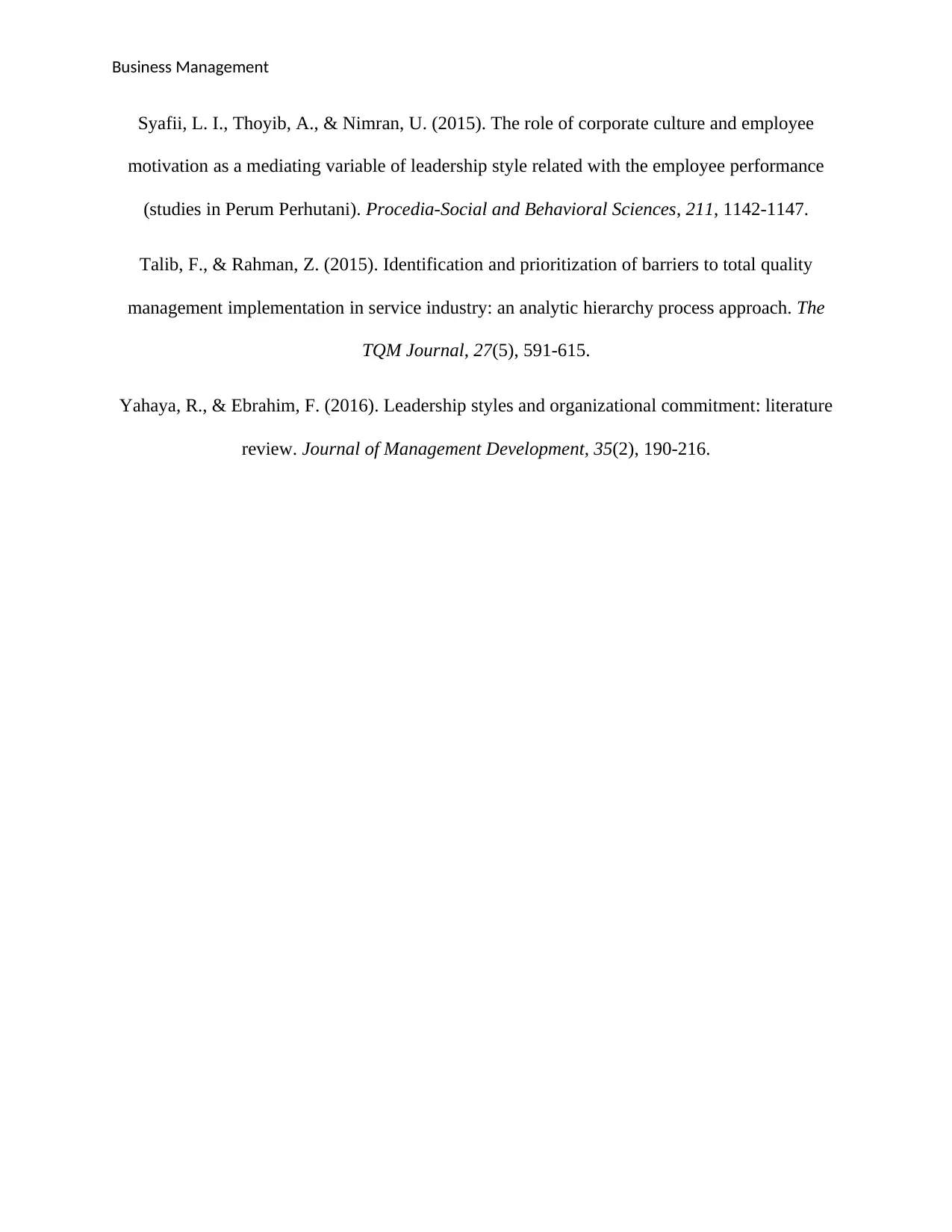
Business Management
Syafii, L. I., Thoyib, A., & Nimran, U. (2015). The role of corporate culture and employee
motivation as a mediating variable of leadership style related with the employee performance
(studies in Perum Perhutani). Procedia-Social and Behavioral Sciences, 211, 1142-1147.
Talib, F., & Rahman, Z. (2015). Identification and prioritization of barriers to total quality
management implementation in service industry: an analytic hierarchy process approach. The
TQM Journal, 27(5), 591-615.
Yahaya, R., & Ebrahim, F. (2016). Leadership styles and organizational commitment: literature
review. Journal of Management Development, 35(2), 190-216.
Syafii, L. I., Thoyib, A., & Nimran, U. (2015). The role of corporate culture and employee
motivation as a mediating variable of leadership style related with the employee performance
(studies in Perum Perhutani). Procedia-Social and Behavioral Sciences, 211, 1142-1147.
Talib, F., & Rahman, Z. (2015). Identification and prioritization of barriers to total quality
management implementation in service industry: an analytic hierarchy process approach. The
TQM Journal, 27(5), 591-615.
Yahaya, R., & Ebrahim, F. (2016). Leadership styles and organizational commitment: literature
review. Journal of Management Development, 35(2), 190-216.
1 out of 10
Related Documents
Your All-in-One AI-Powered Toolkit for Academic Success.
+13062052269
info@desklib.com
Available 24*7 on WhatsApp / Email
![[object Object]](/_next/static/media/star-bottom.7253800d.svg)
Unlock your academic potential
© 2024 | Zucol Services PVT LTD | All rights reserved.





